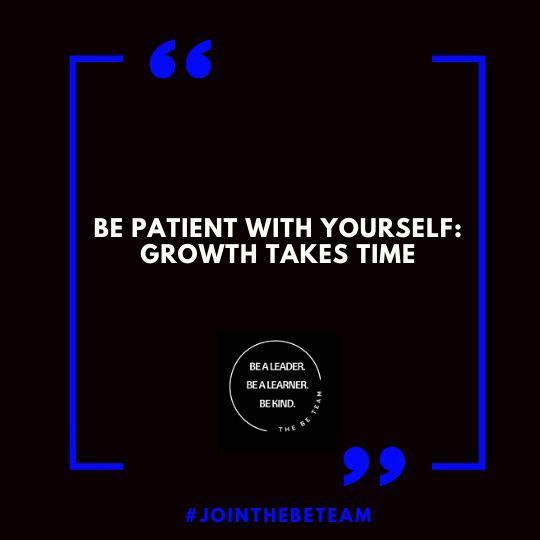Get in touch
jointhebeteam@gmail.com
(205)-392-2326
Follow us
The Be team BLOG
stay up to date
the latest from the be team
Receive an alert anytime a new post drops
Contact Us

Ever Feel Like Your Week Runs You Instead of the Other Way Around? You wake up Monday morning already feeling behind. The to-do list is endless, meetings pile up, and by Friday, you’re wondering where the time went. Sound familiar? That’s because when you don’t plan your week with intention, your week will plan itself—and not in a way that serves you. Instead, you’ll spend your time reacting to everyone else’s priorities instead of making progress on your own. If you want to stop feeling overwhelmed and start feeling in control, it starts with a plan. Why This Matters Time is your most valuable resource. Successful people don’t let their time get hijacked by distractions, interruptions, and last-minute chaos. They set the agenda and make decisions based on their priorities, not someone else’s. When you take control of your week, you: Reduce stress and avoid the feeling of always being behind. Get more done in less time with focused, intentional work. Have space for what truly matters—your health, family, and personal growth. The choice is simple: Run your week, or let it run you. How to Plan Your Week Like a Pro 1. Set Your Non-Negotiables First - Before you get caught up in the noise of emails, meetings, and last-minute requests, identify your non-negotiables—the things that must happen no matter what. - Your personal priorities (workouts, family time, self-care) - Your biggest work goals (projects, deadlines, creative work) - Your key commitments (meetings that truly matter, important calls) Pro Tip: Block these out in your calendar first. If you don’t prioritize them, someone else will fill your time for you. 2. Time Block Like a Pro Successful people don’t just hope they’ll find time for what matters—they schedule it. - Morning Focus Blocks – Use your most productive hours for deep work, strategy, or creative thinking. - Meeting Blocks – Instead of scattered meetings all day, batch them into designated time slots. - Breaks & Buffer Time – Avoid burnout by scheduling pauses and flex time for the unexpected. Pro Tip: If it’s not on your calendar, it’s not a priority. Period. 3. Win the First 90 Minutes of Your Day - How you start your morning sets the tone for your entire day. Instead of diving into emails and distractions, protect your first 90 minutes for high-impact work. - Work on your biggest goal before the world interrupts you. -Avoid reactive tasks like social media and emails. - Set clear intentions: What MUST get done today? Pro Tip: When you own your mornings, you control your day. And when you control your days, you control your life. 4. Plan for the Unexpected No week ever goes exactly as planned. The key is building in flexibility. - Create a “Catch-Up” Block – Leave open time for overflow tasks. - Use a “Must-Do” & “Nice-to-Do” List – Prioritize what truly matters. - Say No More Often – If it doesn’t align with your goals, protect your time. Pro Tip: Disruptions will happen. But when you have a plan, they don’t throw you completely off course. 5. End Your Week with a Reset - Before you wrap up on Friday, take 10 minutes to reflect and reset for the next week. What went well? What needs to be adjusted? What’s the #1 thing you need to focus on next week? Pro Tip: Starting the next week with clarity helps you avoid the Monday scramble and sets you up for success. My Challenge to You Before this week starts: Take 10 minutes to plan your week. • Block your non-negotiables. • Set clear goals. • Protect your time. Because a week well-planned is a week well-lived. Key Takeaways - If you don’t plan your week, your week will plan you. - Schedule your priorities first before others dictate your time. - Use time blocking to stay in control and avoid distractions. - The first 90 minutes of your day can set the tone for success. - Expect the unexpected—build flexibility into your schedule. Join the Conversation How do you plan your week for success? What’s one thing you’ll change about how you schedule your time? Drop your thoughts in the comments! Let’s learn from each other. Like & share if this helped you take back control of your week! Until we meet again: Be a Leader. Be a Learner. Be Kind. Dr. Roy Bishop, Jr. Ready to take your leadership skills to the next level? Click Here to sign up for a complimentary 1-hour leadership consultation with me today! Let's work together to equip you with everything you need to achieve greatness! Check out our website at www.jointhebeteam.com for more tips, tools, and resources for leaders!

Does Empathy guide Your Leadership? How Leading with Your Heart Strengthens Your Team In leadership, it’s easy to focus on what we see—attitudes, behaviors, and outcomes. But the most impactful leaders go beyond the surface, leading with empathy and understanding to create deeper connections within their teams. Leading with your heart is about asking the right questions, fostering trust, and inspiring people to bring their best selves to the table. This week, let’s explore how leading with empathy can transform your team into a thriving, connected, and motivated group. One Thought to Keep in Mind Leading with empathy requires us to pause, look beyond surface-level behaviors, and ask what’s driving someone’s actions. When we lead with our hearts, we build a culture of understanding, trust, and mutual respect. Teams that feel truly understood and supported are more engaged, collaborative, and resilient. By creating space for empathy, we not only solve immediate challenges but also strengthen our team’s foundation for the long term. Two Strategies to Help Lead with Empathy 1. Ask the Right Questions to Foster Understanding: When faced with challenging behaviors or attitudes, resist the urge to judge or react immediately. Instead, ask thoughtful questions that encourage understanding and connection. These questions shift the focus from “what’s wrong?” to “how can I help?” Ideas for Asking the Right Questions: What might this person be experiencing that I can’t see? Am I interpreting their actions fairly, or am I making assumptions? How can I support this person in a way that helps them succeed? Questions to Reflect On: How often do I seek to understand the root cause of someone’s actions? Am I creating a safe space for my team to share their challenges openly? By leading with curiosity, you create an environment where people feel valued and supported, making it easier to address challenges collaboratively. 2. Recognize and Celebrate the Good in People Empathy-driven leadership also involves recognizing the positive attributes and efforts of those we lead. This not only reinforces a culture of positivity but also inspires people to see the best in themselves. Ideas for Celebrating the Good: Regularly acknowledge individual and team accomplishments, both big and small. Offer personalized praise that highlights a person’s unique contributions. Use one-on-one conversations to reflect on each person’s growth and potential. Questions to Reflect On: Do I take time to highlight the strengths of my team members? How can I make recognition a more consistent part of my leadership style? When people feel seen and valued for their efforts, they’re more likely to stay motivated, engaged, and aligned with the team’s mission. One Question to Reflect On How often do you pause to ask, “What support does this person need from me right now?” Reflect on how you can approach the week ahead with this question in mind. Whether it’s offering a listening ear, adjusting expectations, or simply expressing gratitude, small acts of empathy can create big shifts in your team’s culture. Action Step This week, commit to one specific act of heart-forward leadership. Maybe it’s starting a conversation with an open-ended question, celebrating a team member’s progress, or simply asking someone how they’re feeling. Choose an approach that feels authentic and aligned with your team’s needs. Watch how this act of empathy strengthens your connection and builds trust. Final Thoughts Leadership isn’t just about the tasks we assign or the goals we set—it’s about the relationships we build and the culture we foster. When we lead with our hearts, we empower our teams to thrive, both individually and collectively. Empathy isn’t a sign of weakness—it’s a strength that deepens connection, inspires loyalty, and brings out the best in others. As you lead with empathy this week, notice how it transforms not only your team but also your own perspective. Here’s to leading with heart and to the meaningful impact it creates! Until we meet again: Be a Leader. Be a Learner. Be Kind. Dr. Roy Bishop, Jr. Ready to take your leadership skills to the next level? Click Here to sign up for a complimentary 1-hour leadership consultation with me today! Let's work together to equip you with everything you need to achieve greatness! Check out our website at www.jointhebeteam.com for more tips, tools, and resources for leaders!
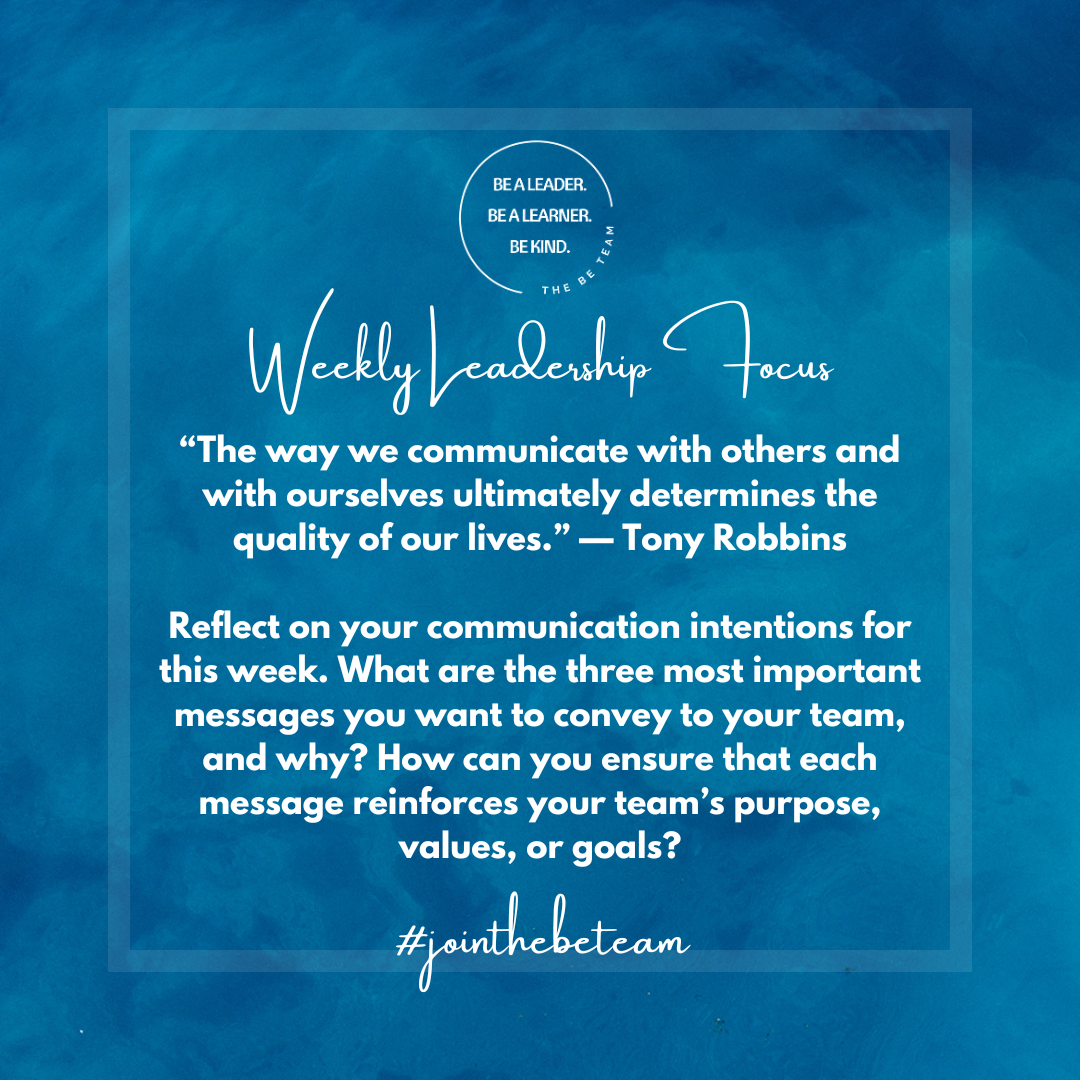
In leadership, communication is more than exchanging information; it's about fostering connection and creating a sense of community. When team members feel genuinely connected, they are not just employees—they are engaged, motivated individuals invested in a shared purpose. But is your communication creating a community that values, trusts, and supports one another? Creating community in the workplace isn’t an automatic outcome; it’s built intentionally through mindful communication, authentic listening, and consistent reinforcement of shared goals and values. This week, let’s explore how purposeful communication can transform your team from a group of individuals into a thriving, supportive community. One Thought to Keep in Mind Building a community requires open, two-way communication where everyone feels valued, heard, and connected to the team’s purpose. Leaders who foster this sense of belonging see higher engagement, loyalty, and productivity. When each person’s voice matters, they’re more likely to contribute, collaborate, and invest in the team’s collective success. Creating community is about nurturing a shared culture where trust, mutual respect, and inclusion are central. Two Strategies to Help Build Community Through Communication 1. Encourage Open Dialogue and Active Listening Creating a space for open dialogue allows team members to feel safe in sharing their ideas, concerns, and insights. When leaders model active listening, they show respect for every individual’s perspective, reinforcing a sense of inclusion and belonging. Consistently encouraging feedback and genuinely considering team input creates a culture where everyone feels invested in the team’s mission. Ideas for Encouraging Dialogue: Start team meetings by inviting questions, ideas, or thoughts that others would like to share. Regularly check in with your team, asking for feedback on current projects or ideas for improvement. Questions to Ask Yourself: How often do I encourage my team to share their thoughts? Do I actively listen and act on the feedback my team provides? By making open dialogue a regular part of your team’s culture, you create a foundation of trust and unity. 2. Create Spaces for Informal Connection Building community goes beyond formal meetings and structured tasks. Creating spaces for informal connection allows team members to connect on a personal level, fostering deeper relationships and trust. When leaders facilitate opportunities for casual conversation, they help their team feel more comfortable sharing ideas, offering support, and collaborating freely. Ideas for Informal Connection: Set up virtual “coffee breaks” or casual meetups where team members can chat about non-work topics. Create a shared “team highlights” board where people can post updates, personal wins, or things they’re excited about. Questions to Reflect On: How often do I encourage non-work-related conversations that build personal connections? What informal spaces can I create to help team members feel more connected? By fostering spaces for informal connection, you encourage team members to build relationships that go beyond work, leading to a more cohesive and supportive community. One Question to Reflect On What’s one area of team culture that could benefit from stronger communication? Reflect on how you can foster connection in that area. Whether it’s encouraging cross-team collaboration, recognizing overlooked contributions, or creating more opportunities for informal check-ins, purposeful communication can strengthen community across all facets of your team’s work. Action Step Identify one specific way to improve communication within your team this week. Maybe it’s scheduling a team-building activity, sending personalized messages of encouragement, or creating a shared space for informal conversation. Choose a method that feels authentic and aligned with your team’s needs. Notice the impact of this added connection on your team’s energy and morale. Final Thoughts Effective communication isn’t just about sharing information—it’s about creating a supportive, inclusive environment where everyone feels a part of something bigger than themselves. When leaders communicate with purpose, they build a community grounded in trust, respect, and shared goals. As you focus on creating connection this week, watch how your team responds with greater engagement, collaboration, and dedication. A strong community isn’t built overnight, but with consistent and intentional communication, it becomes the backbone of a thriving, unified team. Here’s to building community through communication—and to the success that follows! Until we meet again: Be a Leader. Be a Learner. Be Kind. Dr. Roy Bishop, Jr. Ready to take your leadership skills to the next level? Click Here to sign up for a complimentary 1-hour leadership consultation with me today! Let's work together to equip you with everything you need to achieve greatness! Check out our website at www.jointhebeteam.com for more tips, tools, and resources for leaders!

Gratitude is a powerful motivator in any team setting. Showing appreciation can transform team dynamics, boost morale, and create a positive, resilient work environment. When team members feel valued and recognized, they’re more motivated to contribute and support each other. Gratitude in action is about going beyond “thank you” and finding meaningful ways to celebrate your team’s efforts and achievements. This week, let’s explore how showing genuine appreciation can fuel team success. One Thought to Keep in Mind Appreciation isn’t just about recognition—it’s about fostering a culture where every contribution is valued, no matter how big or small. When you actively express gratitude, you create a sense of belonging and purpose within your team. This feeling of appreciation motivates individuals to work harder, support their teammates, and invest in shared goals. Gratitude is the foundation of a thriving team. Two Strategies to Help You Put Gratitude into Action Create a Culture of Ongoing Recognition Make gratitude a regular part of your team’s routine. Recognize efforts consistently—not just during major accomplishments, but for the everyday tasks and small wins that keep things running smoothly. This regular recognition reminds team members that their work is seen and valued, and it helps maintain morale even during challenging times. Ideas for Ongoing Recognition : Start meetings by acknowledging recent achievements, even small ones. Send a quick, personalized thank-you message to team members after a successful project or a job well done. Questions to Ask Yourself : Have I acknowledged my team’s efforts enough this week? How can I make gratitude a routine part of our team culture? By making gratitude a consistent practice, you set the tone for a supportive, motivated, and connected team. Celebrate Contributions Publicly and Personally Public appreciation boosts team morale, but personal acknowledgments can have an even deeper impact. Take time to express gratitude both in team settings and one-on-one. Public recognition highlights individual contributions, while personal notes show that you genuinely value each team member’s unique strengths. Example : At the end of a project, highlight specific contributions in a team email, then follow up with personalized messages to thank each person for their unique role in the success. This approach shows that you see and value everyone’s hard work. Questions to Reflect On : When was the last time I acknowledged each team member’s specific contributions? How can I make my expressions of gratitude more personal and meaningful? These gestures foster trust, reinforce team bonds, and remind everyone that their work makes a difference. One Question to Reflect On What’s one area of your team’s efforts that you might be overlooking? Reflect on how you can show appreciation for the behind-the-scenes work that often goes unnoticed. Recognizing these contributions can inspire a greater sense of ownership and pride within your team. Action Step Identify one way to express gratitude toward your team this week. Whether it’s a small act, like sharing a positive note, or a larger gesture, like a team celebration, commit to showing your appreciation in an authentic way. Notice how your team responds and the positive energy that gratitude brings to your work environment. Final Thoughts Putting gratitude into action is about more than just words; it’s about creating a culture where everyone feels seen, valued, and motivated. As a leader, your appreciation can drive your team to new levels of success and unity. When you actively show gratitude, you build a foundation of trust, respect, and mutual support. So, let gratitude guide you this week—celebrate the wins, recognize the efforts, and watch how your team thrives. Here’s to a week of gratitude in action and the incredible impact it has on your team! The time is NOW. Until we meet again: Be a Leader. Be a Learner. Be Kind. Dr. Roy Bishop, Jr. Ready to take your leadership skills to the next level? Click Here to sign up for a complimentary 1-hour leadership consultation with me today! Let's work together to equip you with everything you need to achieve greatness! Check out our website at www.jointhebeteam.com for more tips, tools, and resources for leaders!
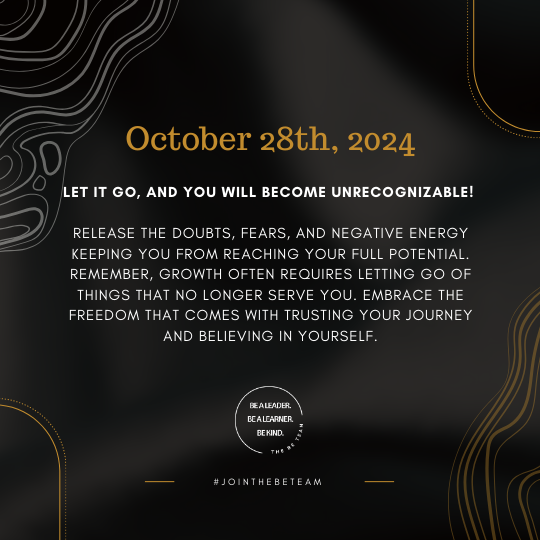
There’s a powerful truth about growth: sometimes, becoming the best version of yourself isn’t about adding more, but about releasing what no longer serves you. We all have aspirations, but too often we let doubt, perfectionism, fear, excuses, and hesitation hold us back from stepping into greatness. Real growth begins when we make space for it. When we release what’s weighing us down, we gain the courage and energy to achieve our goals and move forward with purpose. One Thought to Keep in Mind Letting go isn’t about giving up; it’s about freeing yourself to be the person you’re truly meant to be. By letting go of what limits us, we open ourselves to new opportunities, fresh perspectives, and powerful transformations. Greatness isn’t about being perfect—it’s about embracing who you are today and taking bold steps toward the person you want to become. Two Strategies to Help You Let Go and Move Toward Greatness 1. Challenge Your Inner Critic Self-doubt and perfectionism often stem from an overly critical inner voice. This voice tells you to wait until you’re “ready” or until things are “perfect.” But the truth is, waiting for perfection only keeps you stagnant. Instead of allowing your inner critic to dictate your actions, practice challenging it. When doubt arises, ask yourself: Is this thought helping me grow, or is it holding me back? Replace the negative voice with positive affirmations that encourage you to take action, even if it’s imperfect. Questions to Ask Yourself: What would I do if I wasn’t worried about being perfect? How can I reframe my doubts to see them as challenges I can overcome? Each time you choose progress over perfection, you make a small but powerful step toward greatness. Remember, growth happens outside of your comfort zone—so let go of the need to have it all figured out, and take that first imperfect step forward. 2. Start a “Letting Go” Ritual Sometimes the act of letting go requires a physical reminder. Create a simple ritual to help you release what’s holding you back. For example, write down your fears, doubts, or excuses on a piece of paper and then tear it up or throw it away. Symbolizing the release of these thoughts helps reinforce your decision to let go and move forward. This ritual doesn’t need to be elaborate—what matters is that it serves as a reminder to free yourself from what no longer serves you. Examples of “Letting Go” Rituals: Write down limiting beliefs and throw them away as a signal that they no longer define you. Take a few deep breaths and visualize yourself releasing the things that have been weighing you down. Set an intention to let go each morning, perhaps by repeating a mantra like, “I let go of what I cannot control and focus on what I can.” By practicing a letting-go ritual, you create a habit of actively freeing yourself from negativity, giving you the mental space to focus on your goals and aspirations. One Question to Reflect On What’s one thing you know you need to let go of in order to reach your potential? Reflect on how this thing—whether it’s a fear, excuse, or belief—has held you back. Imagine what you could achieve if it no longer had power over you. Sometimes, visualizing the freedom on the other side of letting go is the first step to making it happen. Action Step Choose one thing you’re ready to let go of and take a step toward releasing it today. It could be as simple as challenging a negative thought, forgiving yourself for a past mistake, or releasing the need for a “perfect” outcome. Write down what you’re letting go of and why, and commit to moving forward without it. Notice how it feels to finally let go and take that energy with you into tomorrow. Final Thoughts To reach greatness, we don’t have to be flawless; we just have to be willing to let go of what holds us back. By releasing doubt, perfection, fear, excuses, and hesitation, we open ourselves up to new possibilities, inner strength, and the courage to pursue our dreams. Remember, greatness isn’t about clinging tightly to what you know—it’s about daring to let go, trusting in your potential, and taking bold steps toward the future you deserve. So let go, make space for growth, and embrace the greatness that’s waiting for you on the other side. The time is NOW. Until we meet again: Be a Leader. Be a Learner. Be Kind. Dr. Roy Bishop, Jr. Ready to take your leadership skills to the next level? Click Here to sign up for a complimentary 1-hour leadership consultation with me today! Let's work together to equip you with everything you need to achieve greatness! Check out our website at www.jointhebeteam.com for more tips, tools, and resources for leaders!

We all have things we've been meaning to start—whether it's pursuing a new career, taking up a hobby, or working on personal growth. But often, we wait for the "right time" to take that first step. The truth is, the perfect moment rarely arrives. There's always a reason to delay: more preparation needed, a busy schedule, or the fear of failure. If you keep waiting, you'll miss out on the opportunities that today has to offer. The best time to start living your life fully is right now. One Thought to Keep in Mind The only moment you truly have is the present. When you put off taking action, you’re letting opportunities slip away. It’s not about having everything perfectly planned or feeling completely ready—it’s about making the most of where you are and what you have today. Starting now, no matter how small the step, is how you build momentum and create change. Each action you take today moves you closer to your goals and transforms your dreams into reality. Two Strategies to Try 1. Take the First Step, No Matter How Small Don't let the size of your goal overwhelm you. Start by taking a small, manageable step toward it today. Even if it’s something simple, like sending an email, making a call, or spending five minutes on research, taking action gets the ball rolling. When you take that first step, you break the cycle of inaction and start building momentum. Questions to Ask Yourself: What’s one small action I can take today that will move me closer to my goal? How can I make that action simple and easy to start? By focusing on just one small step, you create a habit of moving forward, making it easier to take the next step tomorrow. 2. Set a 24-Hour Challenge Give yourself a challenge to take action within the next 24 hours. Whether it's a task you’ve been putting off or a new initiative you want to explore, set a specific goal and a deadline to complete it by tomorrow. This approach forces you to act and eliminates the habit of procrastination. Examples of 24-Hour Challenges: Reach out to someone in your network you’ve been meaning to connect with. Spend 30 minutes working on a project or idea you've been delaying. Schedule a meeting or plan a task for the upcoming week that you’ve been avoiding. Completing a 24-hour challenge will give you a sense of accomplishment and the confidence to keep taking action. One Question to Reflect On What is one goal or task you've been putting off, and why? Reflect on how taking action today could change your situation. What would you gain from starting now instead of waiting? Action Step Pick one thing you’ve been postponing and commit to doing it today. It doesn’t matter how small or insignificant it may seem—what matters is taking action. Once you complete it, note how it feels to finally get started and use that momentum to tackle another task tomorrow. Final Thoughts Stop waiting for the "perfect time" to start living your life. The truth is, there will never be a moment when everything aligns perfectly. The power to make change lies in the actions you take today. When you start living for today, you seize control of your future and open the door to opportunities you never thought possible. Don’t let hesitation hold you back—take action now and watch your life transform, one step at a time. The time is NOW. Until we meet again: Be a Leader. Be a Learner. Be Kind. Dr. Roy Bishop, Jr. Ready to take your leadership skills to the next level? Click Here to sign up for a complimentary 1-hour leadership consultation with me today! Let's work together to equip you with everything you need to achieve greatness! Check out our website at www.jointhebeteam.com for more tips, tools, and resources for leaders!
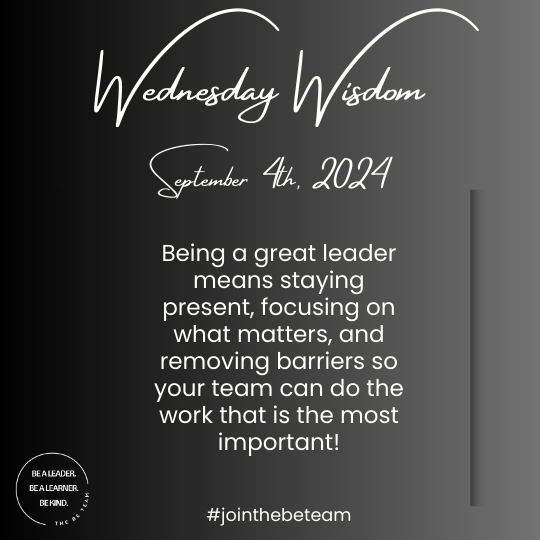
The Daily Leadership Lift/Workout - Wednesday, September 4th Purpose of the Leadership Lift/Workout: Our Daily Leadership Lift/Workout is like a power-packed preworkout for your leadership skills! In just 6 minutes, you'll fuel up with inspiring insights, practical tips, and moments of self-reflection to supercharge your ability to lead with confidence and heart. Whether you're a seasoned pro or just starting out, this daily lift/workout is the ultimate way to elevate your leadership without even breaking a sweat! Today’s Theme: Be Present. Be Focused. Be Engaged. Warm-Up: Daily Reminder: Being a great leader means staying present, focusing on what matters, and engaging fully with your team. Motivational Quote: "The key is not to prioritize what’s on your schedule but to schedule your priorities." – Stephen Covey Positive Affirmation: "I am fully present and engaged in every interaction, and I focus on what truly matters." I am Grateful: Today, I am grateful for the opportunities to connect deeply with my team and for the clarity to focus on our most important goals. Workout: Leadership Question Answered: Q: How can I stay focused and present with so many distractions? A: Staying focused requires intentional effort. Start by minimizing distractions—turn off notifications during important tasks and set specific times to check emails. Practice mindfulness by taking a few deep breaths before meetings to center yourself. Prioritize your tasks, focusing first on what’s most important. Finally, be fully present in conversations—listen actively, and resist the urge to multitask. Two Questions to Consider: 1. When was the last time I was fully present in a conversation? How did it impact the outcome? 2. How can I create a distraction-free environment for my most critical tasks? Two Strategies to Implement: 1. Set Daily Priorities: Each morning, identify your top three priorities and focus on completing them before moving on to less important tasks. 2. Mindfulness Practice: Spend 5 minutes each day practicing mindfulness—whether through meditation, deep breathing, or simply being still. This helps train your mind to stay present and focused. Stretch: Journal Prompt - Reflection: Reflect on a recent time when you struggled to stay focused. What was the result? What steps can you take to improve your focus and presence? What I Am Currently Reading: "Deep Work" by Cal Newport—This book explores the benefits of deep, focused work in a world full of distractions. Newport provides strategies for cultivating a deep work ethic and maximizing productivity. Key Takeaways: 1. Deep Work vs. Shallow Work: Deep work is focused, uninterrupted work that creates significant value, while shallow work is easy, often distracted tasks that don’t contribute much to your goals. 2. The Importance of Focus: In a distracted world, the ability to focus is a superpower. By training your brain to focus deeply, you can achieve more in less time. 3. Creating a Ritual: Develop rituals and routines that help you enter a state of deep work, such as setting specific times for focused work and eliminating distractions. Take Action: This week, schedule one hour each day for deep, focused work on your most important tasks. Protect this time from interruptions, and notice how much more you can accomplish. Final Reminder: Great leaders stay present and focused, ensuring they give their best to every task and interaction. This focus drives meaningful progress and stronger connections with your team. Until we meet again: Be a Leader. Be a Learner. Be Kind. Dr. Roy Bishop, Jr. Ready to take your leadership skills to the next level? Click Here to sign up for a complimentary 1-hour leadership consultation with me today! Let's work together to equip you with everything you need to achieve greatness! Check out our website at www.jointhebeteam.com for more tips, tools, and resources for leaders!
